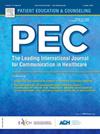Can shared decision-making interventions increase trust/trustworthiness in the physician-patient encounter? A scoping review
IF 2.9
2区 医学
Q2 PUBLIC, ENVIRONMENTAL & OCCUPATIONAL HEALTH
引用次数: 0
Abstract
Objectives
To summarize the existing literature on the impact of shared decision-making (SDM) interventions on patient trust, with a focus on the specific characteristics that influence the effectiveness of each intervention regarding the outcome of trust.
Methods
We conducted a systematic search of the literature with the aid of a research librarian. Data was extracted via Covidence regarding the characteristics of the study including interventions performed, trust scale used, primary and secondary outcomes, and effect size.
Results
From 6090 articles, 97 met criteria for full text review and 20 met inclusion criteria. Sixteen of these were original studies while the remaining 4 were secondary analyses. Eight studies reported a statistically significant increase in trust within the intervention group compared to controls while 12 reported no statistically significant changes. None had trust as a primary outcome.
Conclusion
Interventions aimed at increasing SDM have the ability to increase trust, but do not always succeed at doing so.
Practice implications
The results indicate that increasing SDM can improve trust in the physician-patient relationship, especially when SDM results in improved communication from clinicians. Further studies should look at populations with low baseline trust since a ceiling effect can occur with trust scales.
共同决策干预能否增加医患接触中的信任/可信度?范围审查
目的总结共同决策(shared decision-making, SDM)干预对患者信任影响的现有文献,重点分析影响每项干预对信任结果有效性的具体特征。方法在图书馆员的帮助下,我们对文献进行了系统的检索。通过covid提取有关研究特征的数据,包括实施的干预措施、使用的信任量表、主要和次要结果以及效应大小。结果6090篇文章中,97篇符合全文综述标准,20篇符合纳入标准。其中16项是原始研究,其余4项是二次分析。与对照组相比,8项研究报告了干预组的信任有统计学意义上的显著增加,而12项研究报告没有统计学意义上的显著变化。没有人把信任作为主要结果。结论:旨在提高SDM的干预措施有能力增加信任,但并不总是成功。实践启示结果表明,增加SDM可以提高医患关系的信任,特别是当SDM导致临床医生之间的沟通得到改善时。进一步的研究应该着眼于低基线信任的人群,因为信任量表可能出现天花板效应。
本文章由计算机程序翻译,如有差异,请以英文原文为准。
求助全文
约1分钟内获得全文
求助全文
来源期刊

Patient Education and Counseling
医学-公共卫生、环境卫生与职业卫生
CiteScore
5.60
自引率
11.40%
发文量
384
审稿时长
46 days
期刊介绍:
Patient Education and Counseling is an interdisciplinary, international journal for patient education and health promotion researchers, managers and clinicians. The journal seeks to explore and elucidate the educational, counseling and communication models in health care. Its aim is to provide a forum for fundamental as well as applied research, and to promote the study of organizational issues involved with the delivery of patient education, counseling, health promotion services and training models in improving communication between providers and patients.
 求助内容:
求助内容: 应助结果提醒方式:
应助结果提醒方式:


